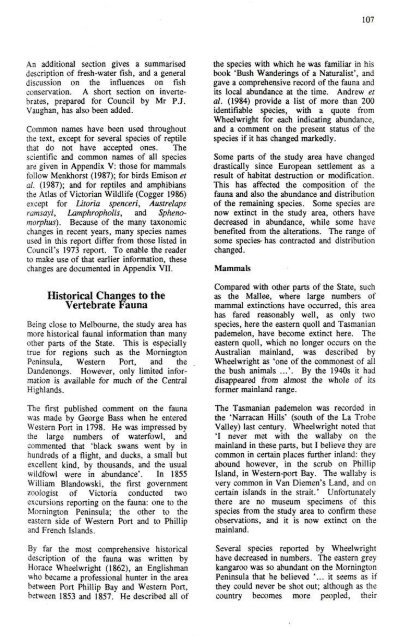Factors Affecting Flora Conservation - Victorian Environmental ...
Factors Affecting Flora Conservation - Victorian Environmental ...
Factors Affecting Flora Conservation - Victorian Environmental ...
Create successful ePaper yourself
Turn your PDF publications into a flip-book with our unique Google optimized e-Paper software.
107<br />
An additional section gives a summarised<br />
description of fresh-water fish, and a general<br />
discussion on the influences on fish<br />
conservation. A short section on invertebrates,<br />
prepared for CouncU by Mr P.J.<br />
Vaughan, has also been added.<br />
Common names have been used throughout<br />
the text, except for several species of reptile<br />
that do not have accepted ones. The<br />
scientific and common names of all species<br />
are given in Appendix V; those for mammals<br />
follow Menkhorst (1987); for birds Emison et<br />
al. (1987); and for reptiles and amphibians<br />
die Atlas of <strong>Victorian</strong> WUdlife (Cogger 1986)<br />
except for Litoria spenceri, Austrelaps<br />
ramsayi, Lamphropholis, and Sphenomorphus).<br />
Because of the many taxonomic<br />
changes in recent years, many species names<br />
used in this report differ from those listed in<br />
CouncU's 1973 report. To enable the reader<br />
to make use of that earlier information, these<br />
changes are documented in Appendix VII.<br />
Historical Changes to the<br />
Vertebrate Fauna<br />
Being close to Melboume, the study area has<br />
more historical faunal information than many<br />
other parts of the State. This is especially<br />
tme for regions such as the Mornington<br />
Peninsula, Western Port, and the<br />
Dandenongs. However, only limited information<br />
is available for much of the Central<br />
Highlands.<br />
The first published comment on the fauna<br />
was made by George Bass when he entered<br />
Western Port in 1798. He was impressed by<br />
die large numbers of waterfowl, and<br />
commented that 'black swans went by in<br />
hundreds of a flight, and ducks, a small but<br />
excellent kind, by thousands, and the usual<br />
wildfowl were in abundance'. In 1855<br />
William Blandowski, the first government<br />
zoologist of Victoria conducted two<br />
excursions reporting on the fauna: one to the<br />
Mornington Peninsula; the other to the<br />
eastern side of Westem Port and to Phillip<br />
and French Islands.<br />
By far the most comprehensive historical<br />
description of the fauna was written by<br />
Horace Wheelwright (1862), an Englishman<br />
who became a professional hunter in the area<br />
between Port Phillip Bay and Westem Port,<br />
between 1853 and 1857. He described all of<br />
the species with which he was familiar in his<br />
book 'Bush Wanderings of a Naturalist', and<br />
gave a comprehensive record of the fauna and<br />
its local abundance at the time. Andrew et<br />
al. (1984) provide a list of more dian 200<br />
identifiable species, with a quote from<br />
Wheelwright for each indicating abundance,<br />
and a comment on the present stams of the<br />
species if it has changed markedly.<br />
Some parts of the study area have changed<br />
drastically since European setdement as a<br />
result of habitat destmction or modification.<br />
This has affected the composition of the<br />
fauna and also the abundance and distribution<br />
of the remaining species. Some species are<br />
now extinct in the study area, others have<br />
decreased in abundance, while some have<br />
benefited from the alterations. The range of<br />
some species-has contracted and disttibution<br />
changed.<br />
Mammals<br />
Compared with other parts of the State, such<br />
as the Mallee, where large numbers of<br />
mammal extinctions have occurred, this area<br />
has fared reasonably well, as only two<br />
species, here the eastern quoll and Tasmanian<br />
pademelon, have become extinct here. The<br />
eastern quoll, which no longer occurs on the<br />
Australian mainland, was described by<br />
Wheelwright as 'one of the commonest of all<br />
the bush animals ...'. By the 1940s it had<br />
disappeared from almost the whole of its<br />
former mainland range.<br />
The Tasmanian pademelon was recorded in<br />
the 'Narracan Hills' (south of the La Trobe<br />
Valley) last century. Wheelwright noted that<br />
'I never met with the wallaby on the<br />
mainland in these parts, but I believe they are<br />
common in certain places further inland: diey<br />
abound however, in the scmb on PhUlip<br />
Island, in Westem-port Bay. The wallaby is<br />
very common in Van Diemen's Land, and on<br />
certain islands in the strait.' Unfortunately<br />
there are no museum specimens of this<br />
species from the study area to confirm these<br />
observations, and it is now extinct on the<br />
mainland.<br />
Several species reported by WTieelwright<br />
have decreased in numbers. The eastern grey<br />
kangaroo was so abundant on the Mornington<br />
Peninsula that he believed '... it seems as if<br />
they could never be shot out; although as the<br />
country becomes more peopled, their
















